
The Atelidae are one of the five families of New World monkeys now recognised. It was formerly included in the family Cebidae. Atelids are generally larger monkeys; the family includes the howler, spider, woolly, and woolly spider monkeys. They are found throughout the forested regions of Central and South America, from Mexico to northern Argentina.

Tetranychus urticae is a species of plant-feeding mite generally considered to be a pest. It is the most widely known member of the family Tetranychidae or spider mites. Its genome was fully sequenced in 2011, and was the first genome sequence from any chelicerate.

The red-crowned woodpecker is a species of bird in the subfamily Picinae of the woodpecker family Picidae. It is found in Costa Rica, Panama, Colombia, Venezuela, Guyana, Suriname, and Tobago.

The black-cheeked woodpecker is a species of bird in subfamily Picinae of the woodpecker family Picidae. It is found from Mexico south to Ecuador.
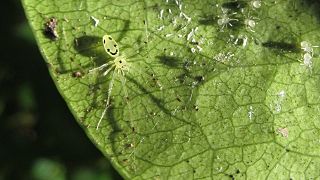
Theridion grallator, also known as the Hawaiian happy-face spider, is a spider in the family Theridiidae that resides on the Hawaiian Islands. T. grallator gets its vernacular name of "Hawaiian happy-face spider" from the unique patterns superimposed on its abdomen, specifically those that resemble a human smiling face. T. grallator is particularly notable because of its wide range of polymorphisms that may be studied to allow a better understanding of evolutionary mechanisms. In addition to the variety of color polymorphisms present, T. grallator demonstrates the interesting quality of diet-induced color change, in which its appearance temporarily changes as it metabolizes various food items.

Peucetia viridans, the green lynx spider, is a bright-green lynx spider usually found on green plants. It is the largest North American species in the family Oxyopidae. This spider is common in the southern U.S., Mexico, Central America, and in many West Indies islands, especially Jamaica. Lynx spiders are hunters specialized for living on plants. This species does not use a web to capture its prey. It pounces on its prey in a cat-like manner, which is the reason for the name lynx. It is active during the day.

The pale chanting goshawk is a bird of prey in the family Accipitridae. This hawk breeds in southern Africa and is a resident species of dry, open semi-desert with 75 cm or less annual rainfall. It is commonly seen perched on roadside telephone poles.
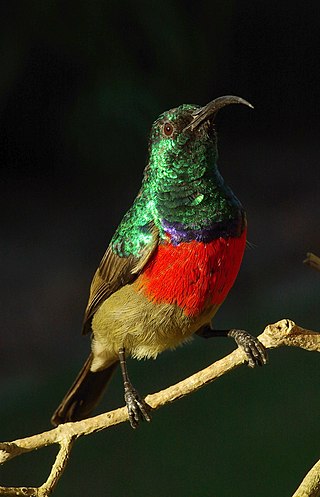
The greater double-collared sunbird, is a small bird in the sunbird family.

The golden-breasted bunting is a passerine bird in the bunting family Emberizidae. It occurs in dry open woodlands and moist savanna in Africa south of the Sahara, but is absent from the equatorial forest belt.

The pale-mandibled aracari or pale-billed araçari is a near-passerine bird in the toucan family Ramphastidae. It is found in Ecuador and Peru.

The Mozambique girdled lizard or flame-bellied armadillo lizard is a large, flattened, girdled lizard found on Mount Gorongosa in Mozambique and low elevations in the Chimanimani Mountains at the border of Zimbabwe and Mozambique. It lives in rock outcrops in grasslands and dry, wooded mountain slopes.

The satinbirds or cnemophilines, are a family, Cnemophilidae of passerine birds which consists of four species found in the mountain forests of New Guinea. They were originally thought to be part of the birds-of-paradise family Paradisaeidae until genetic research suggested that the birds are not closely related to birds-of-paradise at all and are perhaps closer to berry peckers and longbills (Melanocharitidae). The current evidence suggests that their closest relatives may be the cuckoo-shrikes (Campephagidae).
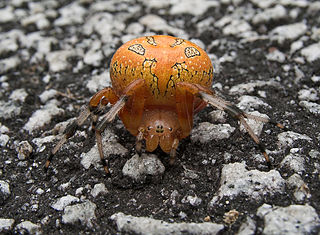
Araneus marmoreus, commonly called the marbled orbweaver, is a species of spider belonging to the family Araneidae. It is sometimes also called the pumpkin spider from the resemblance of the female's inflated abdomen to an orange pumpkin. It has a Holarctic distribution.
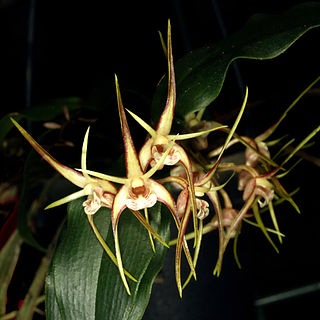
Dendrobium tetragonum, commonly known as the tree spider orchid, is a variable species of epiphytic or lithophytic orchid endemic to eastern Australia. Tree spider orchids are unusual in having pendulous pseudobulbs that are thin and wiry near the base then expand into a fleshy, four-sided upper section before tapering at the tip. There are only a few thin but leathery leaves at the end of the pseudobulbs and up to five flowers on relatively short flowering stems. To allow for the variations in the species there are five subspecies and a variety, some with a unique common name.
Argennina is a monotypic genus of North American cribellate araneomorph spiders in the family Dictynidae containing the single species, Argennina unica. It was first described by Willis J. Gertsch & S. Mulaik in 1936, and has only been found in Texas. Individuals are around 5 mm (0.20 in) in body length. The carapace is a pale yellow brown, sparsely covered with short black hairs, and the abdomen is gray to pale yellow with fine pale hairs.
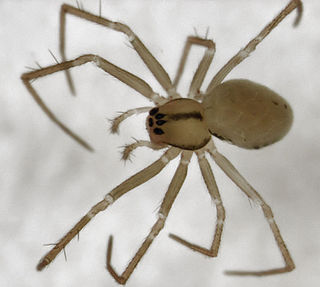
Drapetisca australis is a spider in the family Linyphiidae. It is found in the Antipodes Islands.

Asemonea pinangensis is a species of jumping spider in the genus Asemonea that is endemic to Malaysia. The spider was first defined in 1980 by Fred Wanless. It is a small spider, with a carapace that is typically 1.16 mm (0.046 in) long and an abdomen typically 1.2 mm (0.047 in) long. The carapace is whitish-yellow with black markings and the abdomen black with whitish-yellow markings. The coloration, as well as the lip on its dorsal tibial apophysis, help distinguish the species from the otherwise similar Asemonea maculata, Asemonea minuta and Asemonea tanikawai. The female has not been described.

Alpaida truncata is a species of spider from the genus Alpaida. The species was originally described by Eugen von Keyserling in 1865. The species is widely distributed from Mexico to Argentina.

Alpaida variabilis is a species of spider known for living in wetlands.


















